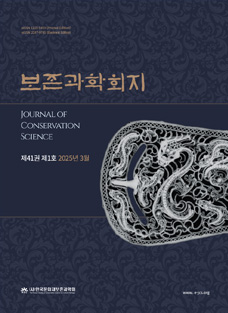Journal of Conservation Science Vol.26 No.1 pp.95-107
조선시대 인골에 대한 생화학적 분석의 유용성: 서천군 옥남리 회곽묘 출토 인골을 중심으로
강소영,권은실,문은정,조은민,서민석,김윤지,지상현
Usefulness of Biochemical Analysis for Human Skeletal Remains Assigned to the Joseon Dynasty in Oknam-ri Site in Seocheon, Korea
Soyeong Kang,Eun-Sil Kwon,Eun-Jung Moon,Eun-Min Cho,Min-Seok Seo,Yun-Ji Kim,Sang-Hyun Jee
Abstract
Biochemical research was carried out on 4 human skeletal remains from historical lime-layered tombs assigned to the Joseon Dynasty in Oknam-ri, Seocheon. The preservation of femur was evaluated by stereoscopic microscopy and scanning electron microscopy. Most of specimens showed good histological preservation. The histological results proved to be a good potentiality for biochemical analysis using bio-molecules. The amelogenin gene and mitochondrial DNA (mtDNA) analyses revealed that three specimens perhaps have maternal consanguinity due to sharing with mtDNA haplogroup D4b1, and two specimens buried in the same tomb were a couple in Gatjaegol site. Carbon and nitrogen stable isotope analysis indicated that four deads diet were built around C3 plant as rice, barley, wheat and bean. In this study we characterized genetic and diet features from the social stratum who could make lime-layered tombs during period of the Joseon Dynasty. The results suggest that biochemical research using the human skeletal remains from the Joseon Dynasty has the great potential and reasonable value for archaeology, anthropology, and population genetics.

 E-Submission
E-Submission 
 E-Submission
E-Submission 
![]() Journal Search Engine
Journal Search Engine




 KSC
KSC